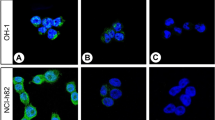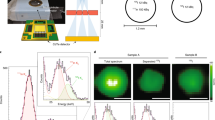Abstract
Monoclonal antibodies to epithelial-cell antigenic determinants, labelled with 123I and 125I, were administered parenterally to immunodeficient mice bearing human tumours derived from a human cancer cell line. Anterior, posterior and lateral radioscans of the body were taken with a gamma scintillation camera at various times from immediately to 65 days after injection. Visual displays of the images were processed by standard computer techniques. The model used a human colon-cancer cell line, HT29, and the monoclonal antibody, AUA1, which is specific to an epithelial proliferating antigen. Tumour detection was achieved in all the mice. The smallest tumour detectable appeared to be about 1 mm in diameter. The degree of antibody uptake in a tumour depended on its size and the blood supply of its surrounding tissues We believe that the technology and skills are now available for accurate radioimmunodetection of cancer in man.
This is a preview of subscription content, access via your institution
Access options
Subscribe to this journal
Receive 24 print issues and online access
$259.00 per year
only $10.79 per issue
Buy this article
- Purchase on Springer Link
- Instant access to full article PDF
Prices may be subject to local taxes which are calculated during checkout
Similar content being viewed by others
Rights and permissions
About this article
Cite this article
Epenetos, A., Nimmon, C., Arklie, J. et al. Detection of human cancer in an animal model using radio-labelled tumour-associated monoclonal antibodies. Br J Cancer 46, 1–8 (1982). https://doi.org/10.1038/bjc.1982.157
Issue Date:
DOI: https://doi.org/10.1038/bjc.1982.157
This article is cited by
-
Side-by-side analysis of five clinically tested anti-EpCAM monoclonal antibodies
Cancer Cell International (2010)
-
The effect of tumor size on F-18-labeled fluorodeoxyglucose and fluoroerythronitroimidazole uptake in a murine sarcoma model
Annals of Nuclear Medicine (1999)
-
Diagnostic and therapeutic applications of monoclonal antibodies in colorectal cancer
Diseases of the Colon & Rectum (1998)
-
Monoclonal antibody uptake in B-cell lymphomas: Experimental studies in nude mouse xenografts
Cancer Immunology Immunotherapy (1993)
-
Immunodetection of thyroid tumors: role of immuno aggregates
Journal of Endocrinological Investigation (1991)



